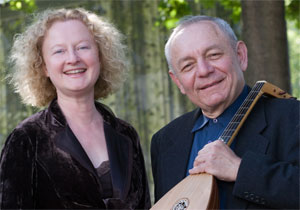Classical Music Review: The Boston Camerata’s Enthralling Hispanic Christmas
Spirits were lifted; those in need of holiday cheer got a massive dose of it. Bravo to The Boston Camerata and to Les Fleurs des Caraïbes.
By Susan Miron
The Boston Camerata, celebrated for its fascinating holiday-time concerts, performed a series of four concerts the week of December 15–22 around Boston entitled The Brotherhood of the Star: A Hispanic Christmas 1300–1700. This was actually a recap of a program they had done in 2008, but I had missed that one, and was thrilled to have a chance to hear it. Playing, as it usually does, to a full and enthusiastic crowd in Lexington’s Hancock United Church of Christ on Friday night, the Camerata’s eight musicians performed with Les Fleurs des Caraïbes, the six voice, Haitian women’s chorus based in Boston.
The titular Brotherhood of the Star, which comprises three parts of the Camerata’s program, comes from “Negritos a la Navidad del Sr” by Juan de Araujo (Spain, 1646-Bolivia, 1712). “It’s about the three kings, and they’re all black men,” Music Director (1968-2008) Emeritus Joel Cohen explains, “and they’re dancing the rhumba as they go to Bethlehem. It’s totally world music before that term was invented because it’s got these wonderful Hispanic rhythms and they’re singing in an African-Spanish dialect about the newborn Child.”
Coming out of retirement for these concerts, Mr. Cohen chose selections from geographically and historically diverse areas and times, creating an ever-changing tapesty of sound and styles. The vocalists and instrumentalists—often doubling as both—rarely remained the same for two consecutive pieces. The ever-changing textures and styles worked beautifully—there was not a routine moment.
The Brotherhood of the Star opened with an impassioned, unaccompanied solo, the early twentieth-century Sephardic/Turkish “Adonay oi me estremeci“–”Lord, hear me and protect me from that terrible Day of Judgment, for you are great”—sung beautifully by tenor Daniel Hershey. That was followed by the “Madre de Deus” by Alfonso el Sabio, King of Castille (1221–84), which teamed the uniquely compelling voice of Anne Azéma with the sounds of virtuoso cornettist Michael Collver (who doubled as the evening’s excellent countertenor).
The evening was full of quick rearrangements of singers and instrumentalists (vocalists often played instruments as well, including the hurdy-gurdy and renaissance guitar). What constantly impressed me about the concert was its seamless movement through real and historical time and space. One piece elegantly elided into the next. This was a highly polished show yet always spontaneous, combining superior musicianship and rousing joy.
“To the Honored Lady” featured 12 selections, moving from four Gregorian chants through two more lovely pieces by Alfonso el Sabio, several pieces by sixteenth-century composers, including Francesco Guerrero and his Anonymous colleagues, and on to the twentieth century “Morena me llaman”—”They call me the dark one, but I was born light: my color changed from much wandering.” The last song, “Riu riu chiu” by an undeservedly Anonymous of the sixteenth century, was sheer exuberance, with the enthused singers including Mr. Cohen singing and clapping, filling the hall with merriment.
So many of the pieces were memorable, but for me, one highlight was soprano Salomé Sandoval’s soulfully spellbinding performance of the nineteenth-century, Andalusia lullaby, “Duermate, niño, duérme” with its Hebrew-sounding melodic melismas. Whenever the three men (tenor Daniel Hershey, countertenor Michael Collver, and the superb bass-baritone Don Wilkinson) sang together, as they did in Anonymous’s (c. 1450) “Reina muy esclarecida“(“Shining Queen”), extraordinary music-making occurred. The instrumentalists were all spot-on. Carol Lewis played vielle and viola da gamba, Cohen plucked several lutes and played percussion, including, in the last piece, a maraca. The excellent baroque guitarist Olav Chris Henriksen also played oud. Besides singing beautifully, Salomé Sandoval played renaissance guitar and vihuela.
A Catalan folksong, “Que li darem?” (“What shall we give to the child of the Mother?”), became an audience sing-along for verses two and four. Finally, a lively guaracha, “Convidando esta la noche” by Juan Garcia de Zèspiedes (Mexico, c. 1650) recounts creating music for the Child in a compellingly rhythmic fashion, with solemn and quick refrains alternating. Ms. Azéma and the three male singers began the song slowly, then suddenly Ms. Sandoval (with guitar) sang it joyously. Mr. Cohen conducted with a maraca. With its rich mixture of percussive castanets and plucked strings, the performance became a celebration in sound. Spirits were lifted; those in need of holiday cheer got a massive dose of it. Bravo to the entire ensemble and to Les Fleurs des Caraïbes.
Susan Miron, a harpist, has been a book reviewer for over 30 years for a large variety of literary publications and newspapers. Her fields of expertise were East and Central European, Irish, and Israeli literature. Susan covers classical music for The Arts Fuse and The Boston Musical Intelligencer.


